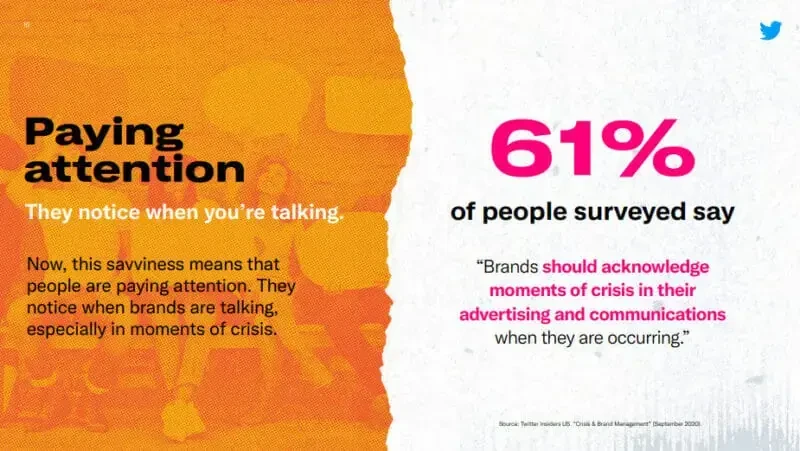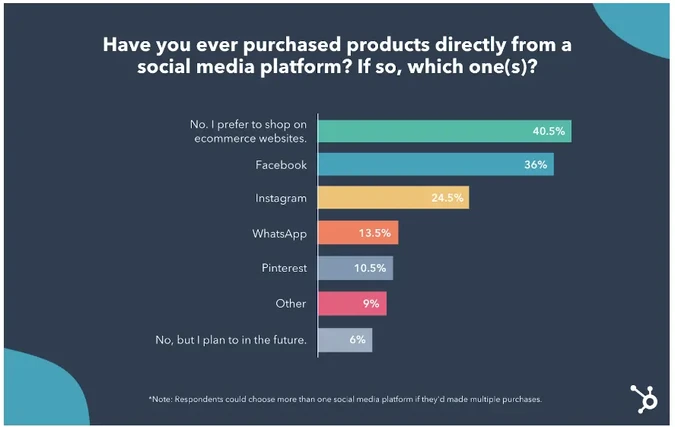THE POWER OF SOCIAL MEDIA IN 2023---NIDM
1. Crisis Management for Social Media Will Be Essential
A PWC survey shows us that more than 95% of businesses expect to face a crisis within the next two years. The problem is that many companies still don’t have a designated crisis response team or a crisis plan in place.
Social media platforms have become a vehicle for spreading information quickly. This includes issues, both minor and major. When left unaddressed, one seemingly minor issue can transform into an even bigger one, causing significant damage to your business, such as financial damage and damage to your reputation. One example is Peloton. The brand’s Tread and Tread+ machines were recalled after an accident that led to the death of a six-year-old child. Despite the pressing nature of this issue, Peloton didn’t immediately address the issue, recalling the products in question only a month after the incident. Because of this, it faced backlash from consumers and social media users.
According to a survey commissioned by Twitter, 61% of respondents feel that brands should be able to acknowledge crises as they happen through their advertising and communications.

Furthermore, using social media as a crisis management tool can help businesses regain the trust of their audience. As many as 81% of respondents believe that social media has helped improve businesses/ accountability. The same report goes on to say that 89% of people say that a business can regain their trust if it’s transparent, meaning that it takes steps to admit its mistake and what it will do to address the issue.
Because of how social media is utilized nowadays, not only by users but also by businesses, it can be used as a potentially powerful crisis management tool.
2. Brand Authenticity Will Be the Way to Go
It’s no secret that consumer behavior is ever-evolving. Consumers nowadays demand authenticity from brands, with 86% of consumers saying that transparency has now become more important than ever. Aside from transparency, today’s consumers expect businesses to nurture authentic human connections and build an emotional connection to a brand. One example of how brands can nurture authenticity is by empowering their leaders to play a more proactive role on social media.
Apart from fostering long-term trust, transparency can help consumers continue to do business with a brand even during a crisis. Millennial consumers in the same survey, for instance, want brands to be more transparent on social media, with 69% of them wanting a company’s CEO to have a “personal presence” on social media channels and that CEOs have the power to make a positive impact when they’re transparent, according to 71% of millennial consumers.
Moreover, when brands work toward building more authentic relationships and deeper connections with their audience, they’re more likely to enjoy a slew of benefits, such as improved brand reputation and better sales figures.
3. The Use of Social Media as Shopping Outlets Will Remain Popular
In 2022, we witnessed the steady rise of social commerce, which allowed social media users to purchase products directly on social media. In 2023, social media platforms are expected to continue to become popular shopping outlets for consumers.
Furthermore, it’s projected that by 2026, global social commerce sales will reach a whopping $6 trillion, with the US having approximately 108 million social buyers by 2025.
A HubSpot survey shows that 36% of social media users purchased a product directly from Facebook, followed by 24.5% of consumers who used Instagram to buy products on social media.

Social media platforms are quick to catch on to this trend. Facebook, for example, has rolled out its “Facebook Shops” feature, which allows businesses to create a “Shop” complete with product listings, the ability to let users add these products to their shopping cart, and purchase such products directly from a dedicated checkout page. Plus, once businesses have set up their Facebook Shop, they can integrate it with their Messenger account, giving their audience a more seamless shopping experience.
However, it’s probably not going to be a smooth ride for social commerce. Despite presenting a significant opportunity for growth, social commerce may not yet be a viable solution for some brands. Before joining the social commerce bandwagon, you may want to do extensive research on your target market and preferred platform to see if they’re capable of supporting social commerce initiatives and to determine whether or not that platform is capable of scaling with your growth.
4. Short-Form and Bite-Sized Content Will Dominate Social Media Platforms
It’s expected that in the coming years, a majority of online content will be video content. This prediction is relevant, given that 86% of businesses are already using video as a marketing tool. However, the spotlight will be on short-form and bite-sized content. Aside from being able to potentially generate more engagement from your audience, they can be invaluable tools for marketing and education, given that 73% of people prefer to watch a short video to learn more about a product or service, according to the same report.
Bite-sized content, like short-form videos, also allows brands to still drive engagement even if today’s audience has a shorter attention span, with the average human attention span now clocking in at 8.25 seconds. For example, Twitter introduced Fleets, a feature that’s Similar to Snapchat Stories, where posts or videos disappear after 24 hours.
Now, this doesn’t mean that brands should compromise quality when creating bite-sized content. Despite shorter attention spans, high-quality content still has the power to cut through the noise and hold your audience’s attention.
Want to create your own short-form video content? Here’s our quick guide, complete with best practices you can follow to create outstanding bite-sized content your audience will love.
5. The Phasing Out of Third-Party Cookies
It’s projected that by 2023, we’ll start to see the end of third-party cookies. While third-party cookies allow brands to offer more personalized experiences to their audience, they’re facing backlash due to growing privacy concerns. Moreover, consumers are growing frustrated over this issue and are looking for an immediate solution.
What does this mean for brands and social media platforms? In the coming years, you can expect to see measures, such as the creation of reliable first-party solutions, being rolled out. Furthermore, brands and social media platforms will have to prioritize consumer privacy and transparency, as we can expect laws and regulations similar to the GDPR to continue to be developed around the world.
6. Decentralized Networks Will Become Alternatives to Mainstream Social Media Platforms
Decentralized social networks will become a viable alternative to mainstream social media platforms in the coming years. This is due in part to issues such as the user’s lack of control and censorship. Next year, we may see such decentralized platforms start to gain traction as consumers demand more control and better data privacy measures. We’re already seeing such platforms emerge. For example, Minds is an open-source alternative to popular social media platforms Facebook and Instagram, while Mastodon is quickly becoming a Twitter alternative. Other decentralized platforms you can start exploring now include LBRY (YouTube alternative), Diaspora (Facebook alternative), and Signal (WhatsApp and Messenger alternative).
7. Sustainability and the Environment Will Become More of a Priority
Environmental buzzwords are quickly becoming a thing of the past. Today’s consumers don’t want to listen to words like “sustainability” or “eco-friendly—they want to take action to make an impact. Moreover, they’re expecting brands to act on environmental issues, with 82% of consumers wanting companies to prioritize the two Ps—people and planet—instead of profit. It’s projected that by next year, you can expect to see brands taking action to perform better in the market.
8. AI Will Play a Big Role in Post Recommendations (Facebook and Instagram)
2023 will be an even bigger year for AI. You can expect to see more content on social media platforms, such as Facebook and Instagram, being recommended by AI to drive increased user engagement. Facebook, for example, is introducing measures, such as displaying more recommended content on a user’s newsfeed. This makes TikTok-like discovery via the For You page possible.
9. Integrations Might Play a Bigger Role on Social Media Platforms
Integrations continue to gain traction on popular social media platforms, according to a prediction made by SocialMediaToday’s Andrew Hutchinson. Facebook, for example, is working on integrating digital avatars to encourage engagement, especially in the metaverse. Instagram, meanwhile, will also be banking on integrations for creating different content forms in a bid to support creators and empower them to create content in the metaverse, according to Hutchinson. Other social media platforms are likely to follow suit.
10. Interactive Ads Will Gain Traction
Extended reality technologies, such as AR and VR, have opened up new opportunities for user engagement. One popular use case for such technologies is filters. However, they can also be used to deliver better shopping experiences to a brand’s audience, such as through interactive ads. This type of advertising allows users to participate in the ad experience instead of blocking them using ad blockers or skipping ads altogether. Allowing users to participate in such an “experience” increases the likelihood of them engaging with a particular brand or product. Aside from getting more viewing time from your audience than traditional ads, the use of interactive ads can help drive brand awareness.
11. Nano-Influencer and Micro-Influencer Marketing Will Become Mainstream
Influencer marketing isn’t just about big names on Instagram or TikTok. While they may have amassed an army of followers, their influence also often comes at a high price, which can prevent smaller brands from working with them. Plus, given the volume of their followers, engaging with them can be challenging.
Furthermore, today’s consumers are increasingly gravitating toward more authentic experiences and are open to engaging with brands and influencers that offer not only value, but also authenticity. Thus, in the coming years, you can expect to see more brands working with nano- and micro-influencers. Despite their relatively smaller following, nano- and micro-influencers often have higher engagement. Nano-influencers, for instance, have an average engagement rate of 3.69%, which is higher than that of macro-influencers.
In the coming years, we can expect to see nano- and micro-influencers take center stage as more brands are likely to opt for a more “community-led approach.”
12. The Human Touch Will Play a More Prominent Role
User-generated content made waves in 2022, with brands like Daniel Wellington and Dove encouraging their audience to participate in their campaigns or create their own content featuring their brand. Next year, this trend is highly likely to become even bigger, with brands leveraging the power of the human touch to nurture authenticity and drum up engagement. As brands become more interactive, we may also start seeing a more “relaxed” approach to audience engagement. For example, brands may start using more conversational tones or taking steps to make their image more relatable and accessible to their target audience, instead of the usual carefully curated image that audiences are used to seeing.
13. Gaming Will Become an Alternative to Social Media Platforms
The gaming industry is projected to reach $321 billion by 2026. Its growth is attributed to factors such as people finding new ways to entertain themselves during the lockdowns while maintaining their social connections, according to G2A.com co-founder and CEO Bartosz Skwarczek. The growing popularity of AR and VR games is also a major driving force for the industry’s growth.
While it won’t be replacing social media any time soon, given its sheer size, the gaming industry presents ample opportunities for brands to drive social interaction and community engagement. While nothing is definite yet, we may start to see brands leveraging the potential of the gaming industry to drive social interactions.
NIDM- NATIONAL INSTITUTE OF DIGITAL MARKETING IS ONE OF THE LEADING DIGITAL MARKETING TRAINING INSTITUTE IN BANGALORE WHICH PROVIDE 100% PLACEMENT
.jpg)
Comments
Post a Comment